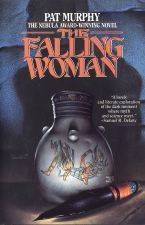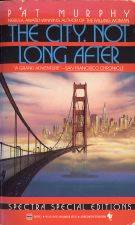

| Click on a book's image or title to order from Amazon.com |

The Falling Woman
Orb, TPB, © 1986, 287 pp, ISBN #0-312-84508-4Reviewed January 1999
This book won the 1987 Nebula Award for best novel.
The Falling Woman is the story of an archaeologist, Liz Butler, and her now-adult daughter, Diane, from whom she became estranged when her marriage broke up (an event which resulted in Liz being committed to an asylum). When Diane's father dies, she travels to Mexico to join Liz on a Mayan dig.
Liz, on the other hand, has been seeing ghosts since the waning years of her marriage. These ghosts are unobtrusive, shadows of times past who go about their business, then walk into walls and vanish. By examining the spots in which she sees these ghosts, Liz has amassed a significant reputation in the Mayan archaeological community - and she's kept the source of her "good fortune" a secret from others. Things change when, one day, a Mayan ghost named Zuhuy-kak begins to talk to Liz, and to warn her of the cycle which is ending - in both their time periods - and the gods that must be appeased to prevent disaster from coming.
The Falling Woman is written in a lush, flowing style which is sometimes lovely to read, but other times feels like a barrier between the reader and the minds and feelings of the two main characters. (The book is narrated by them in turns.) Despite the raw emotions lying underneath the surface, the characters always seem oddly detached from it all, examining the events of the story clinically. This enhances the eerie atmosphere of the story, with an exotic locale, peculiar ghosts, and strange events. This atmosphere - and the background of Mayan culture and archaeology - are the book's strengths.
Unfortunately, the book's main weakness is its thin plot, a concern for me since I prefer strong plots in books I read. The conflict between Liz and Diane is not really resolved, and indeed it's hard to see that much has changed by the end of the book, except that they are still in contact with each other. And the ghost-driven events of the end of a Mayan cycle all seem quite slim, driving the characters into hysteria over what seems ultimately to be nothing.
I was quite disappointed in this novel, which had such intriguing premises, but didn't really take them anywhere.

The City, Not Long After
Bantam Spectra, PB, © 1989, 258 pp, ISBN #0-553-28370-7Reviewed May 1998
The City, Not Long After takes place a couple of decades after a plague wiped out most of humanity. A small fraction of people survive to create new lives. The story takes place in and around San Francisco, focusing primarily on a young woman who is born shortly after the plague and grows up with her mother, without a name. After her mother's death, she learns that a local military group plans to invade the city, so she travels there to warn them.
San Francisco is inhabited primarily by artists, who make use of the "canvas" of the city to create bizarre constructs and effects, admired primarily only by themselves. The woman takes a name, Jax, and becomes involved with Danny-Boy and the community around him, until the army attacks.
I seem to read a lot of post-apocalyptic novels. I'm not sure why; I don't especially like or dislike them more than any other variety of science fiction. It just works out that way.
I decided to read The City, Not Long After after reading Michaela Roessner's Vanishing Point, as I had heard that several San Francisco-area writers had semi-deliberately each written a book which took place after a great tragedy had descended on the bay area. Certainly The City and Vanishing Point have a lot in common in that respect, but a more apropos comparison, I think, is with David Brin's The Postman.
In many senses, The City is a thematic opposite to The Postman. Most obviously, in The Postman, the dream of a "Restored United States of America" is a banner around which the remnants of civilization in the Pacific Northwest can rally. In The City, the symbol of the US is General Fourstar, soldier and would-be petty dictator who fills the role of the villain of the book.
Also, the fundamental theme of The Postman is the responsibility of men of conscience who possess power or authority to use their abilities and position to improve conditions for all people, and that refusing to use such power is wrong. But in The City, the war against General Fourstar is fought almost exclusively to avoid killing anyone, and that stooping to the use of guns and killing would make the heroes "no better than the people they're fighting" (an oft-invoked mantra which explains why comic book superheroes don't kill their foes).
And although the slightly-grim tone of the two books is similar (most post-apocalyptic stories share this trait, including Vanishing Point and A Canticle For Leibowitz), The Postman is more concerned with the nuts-and-bolts of rebuilding human society, while The City regards such rebuilding as almost-useless. "There's a lot to be said for chaos", says Danny-Boy while talking to Fourstar's advance party. The Postman examines ways that one man can turn the tide for a large group of people, while The City isn't really concerned with group dynamics at all.
The City, Not Long After has strong mystical overtones, and at times it seems that the city brings forth strange apparitions, sudden snowfalls, and a rainfall of flowers to help, comfort and bewonder the inhabitants. No explanation for these events is provided or suggested, which moves the book a little into the realm of fantasy (I prefer my novels to be straight science fiction, so this was mildly annoying to me).
But it's also a very romantic novel, as Jax - who has grown hard during her life alone with her mother - discovers what it's like to live with other people, and to belong. Jax and Danny-Boy are likeable characters, although they always seem a little distant from the reader, a little outre, as opposed to the very down-to-earth supporting cast (Books, who works in the library, and Ms. Migsdale, who edits the local newspaper).
I think I would give the nod to The Postman as the better of the two books, but The City, Not Long After is interesting on its own terms, and in contrast to that other novel.
hits since 13 August 2000.